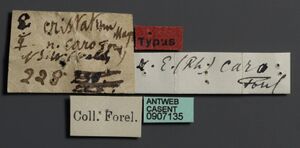Rhytidoponera aciculata
| Rhytidoponera aciculata | |
|---|---|

| |
| Scientific classification | |
| Kingdom: | Animalia |
| Phylum: | Arthropoda |
| Class: | Insecta |
| Order: | Hymenoptera |
| Family: | Formicidae |
| Subfamily: | Ectatomminae |
| Tribe: | Ectatommini |
| Genus: | Rhytidoponera |
| Species: | R. aciculata |
| Binomial name | |
| Rhytidoponera aciculata (Smith, F., 1858) | |
| Synonyms | |
| |
Identification
Distribution
Latitudinal Distribution Pattern
Latitudinal Range: -28.53952° to -33.11666667°.
| North Temperate |
North Subtropical |
Tropical | South Subtropical |
South Temperate |
- Source: AntMaps
Distribution based on Regional Taxon Lists
Australasian Region: Australia (type locality).
Distribution based on AntMaps
Distribution based on AntWeb specimens
Check data from AntWeb
Countries Occupied
| Number of countries occupied by this species based on AntWiki Regional Taxon Lists. In general, fewer countries occupied indicates a narrower range, while more countries indicates a more widespread species. |

|
Estimated Abundance
| Relative abundance based on number of AntMaps records per species (this species within the purple bar). Fewer records (to the left) indicates a less abundant/encountered species while more records (to the right) indicates more abundant/encountered species. |

|
Biology
Castes
Worker
Images from AntWeb
   
| |
| Syntype of Ectatomma cristatum caro. Worker. Specimen code casent0907135. Photographer Will Ericson, uploaded by California Academy of Sciences. | Owned by MHNG, Geneva, Switzerland. |
Nomenclature
The following information is derived from Barry Bolton's Online Catalogue of the Ants of the World.
- aciculata. Ectatomma aciculata Smith, F. 1858b: 104 (w.) AUSTRALIA (New South Wales).
- Type-material: holotype worker.
- Type-locality: Australia: Hunter River, “51/36” (no collector’s name).
- Type-depository: BMNH.
- Clark, 1936: 56 (m.); Imai, Crozier & Taylor, 1977: 347 (k.).
- Combination in Ponera (Ectatomma): Roger, 1860: 307;
- combination in Ectatomma: Roger, 1863b: 17;
- combination in E. (Rhytidoponera): Emery, in Dalla Torre, 1893: 23;
- combination in Rhytidoponera: Emery, 1911d: 38.
- Subspecies of punctata: Forel, 1907h: 268; Emery, 1911d: 38; Forel, 1913g: 174.
- Status as species: Mayr, 1863: 409; Roger, 1860: 307; Roger, 1863b: 17; Mayr, 1886c: 358; Dalla Torre, 1893: 23; Clark, 1936: 55 (redescription); Brown, 1958g: 202, 263; Taylor & Brown, 1985: 40; Taylor, 1987a: 67; Bolton, 1995b: 378.
- Senior synonym of caro: Clark, 1936: 55; Taylor & Brown, 1985: 40; Taylor, 1987a: 67; Bolton, 1995b: 378.
- Material of the unavailable name laevior referred here by Brown, 1958g: 202; Bolton, 1995b: 378.
- Distribution: Australia.
- caro. Ectatomma (Rhytidoponera) cristatum subsp. caro Forel, 1910b: 11 (w.) AUSTRALIA (New South Wales).
- Type-material: syntype workers (number not stated).
- Type-locality: Australia: New South Wales (Froggatt).
- Type-depositories: ANIC, MHNG, NHMB.
- Combination in Rhytidoponera: Emery, 1911d: 38.
- Subspecies of cristata: Emery, 1911d: 38.
- Junior synonym of aciculata: Clark, 1936: 55; Taylor & Brown, 1985: 40; Taylor, 1987a: 67; Bolton, 1995b: 378.
Type Material
- Ectatomma aciculata: Syntype, 3 workers (1 labelled as holotype), Hunter River, New South Wales, Australia, The Natural History Museum.
- Ectatomma (Rhytidoponera) cristatum caro: Syntype, 2 workers, Walcha, New South Wales, Australia, Froggatt,W.W., ANIC32-011923, Australian National Insect Collection.
The following notes on F. Smith type specimens have been provided by Barry Bolton (details):
Ectatomma aciculata
Holotype worker in The Natural History Museum. Labelled “Hunter River,” (Australia) and “51/36.” Acc. Reg.: “1851 no. 36 (April 16th). Hunter River. Purchased from Mr Ker. Bill 1851.A.26.”
Description
Karyotype
- n = 26, 2n = 52, karyotype = 18M + 34A (Australia) (Imai et al., 1977; Mariano et al., 2015).
References
- Barlow, M.M., Bicknell, R.D.C., Andrew, N.R. 2019. Cuticular microstructure of Australian ant mandibles confirms common appendage construction. Acta Zoologica 101, 260–270 (doi:10.1111/azo.12291).
- Brown, W. L., Jr. 1958g. Contributions toward a reclassification of the Formicidae. II. Tribe Ectatommini (Hymenoptera). Bulletin of the Museum of Comparative Zoology 118: 173-362 (page 202, Senior synonym of caro, and material of the unavailable name laevior referred here)
- Clark, J. 1936. A revision of Australian species of Rhytidoponera Mayr (Formicidae). Mem. Natl. Mus. Vic. 9: 14-89 (page 55, Revived status as species)
- Clark, J. 1936. A revision of Australian species of Rhytidoponera Mayr (Formicidae). Mem. Natl. Mus. Vic. 9: 14-89 (page 56, male described)
- Dalla Torre, K. W. von. 1893. Catalogus Hymenopterorum hucusque descriptorum systematicus et synonymicus. Vol. 7. Formicidae (Heterogyna). Leipzig: W. Engelmann, 289 pp. (page 23, Combination in E. (Rhytidoponera))
- Emery, C. 1911e. Hymenoptera. Fam. Formicidae. Subfam. Ponerinae. Genera Insectorum 118: 1-125 (page 38, Combination in Rhytidoponera)
- Forel, A. 1907j. Formicidae. In: Michaelsen, W., Hartmeyer, R. (eds.) Die Fauna Südwest-Australiens. Band I, Lieferung 7. Jena: Gustav Fischer, pp. 263-310. (page 268, Subspecies of punctata)
- Forel, A. 1913h. Fourmis de Tasmanie et d'Australie récoltées par MM. Lae, Froggatt etc. Bull. Soc. Vaudoise Sci. Nat. 49: 173-195 (page 174, Subspecies of punctata)
- Heterick, B.E. 2021. A guide to the ants of Western Australia. Part I: Systematics. Records of the Western Australian Museum, Supplement 86, 1-245 (doi:10.18195/issn.0313-122x.86.2021.001-245).
- Heterick, B.E. 2022. A guide to the ants of Western Australia. Part II: Distribution and biology. Records of the Western Australian Museum, supplement 86: 247-510 (doi:10.18195/issn.0313-122x.86.2022.247-510).
- Imai, H. T.; Crozier, R. H.; Taylor, R. W. 1977. Karyotype evolution in Australian ants. Chromosoma (Berl.) 59: 341-393 (page 347, karyotype described)
- Mariano, C.S.F., Santos, I.S., Silva, J.G., Costa, M.A., Pompolo, S.G. 2015. Citogenética e evolução do cariótipo em formigas poneromorfas. In: Delabie, J.H.C., Feitosa, R.M., Serrao, J.E., Mariano, C.S.F., Majer, J.D. (eds) As formigas poneromorfas do Brasil, 1st edn. Ilhéus, Brasil, pp 102–125 (doi:10.7476/9788574554419.0010).
- Smith, F. 1858b. Catalogue of hymenopterous insects in the collection of the British Museum. Part VI. Formicidae. London: British Museum, 216 pp. (page 104, worker described)
References based on Global Ant Biodiversity Informatics
- Stitz H. 1911. Australische Ameisen. (Neu-Guinea und Salomons-Inseln, Festland, Neu-Seeland). Sitzungsberichte der Gesellschaft Naturforschender Freunde zu Berlin 1911: 351-381.

